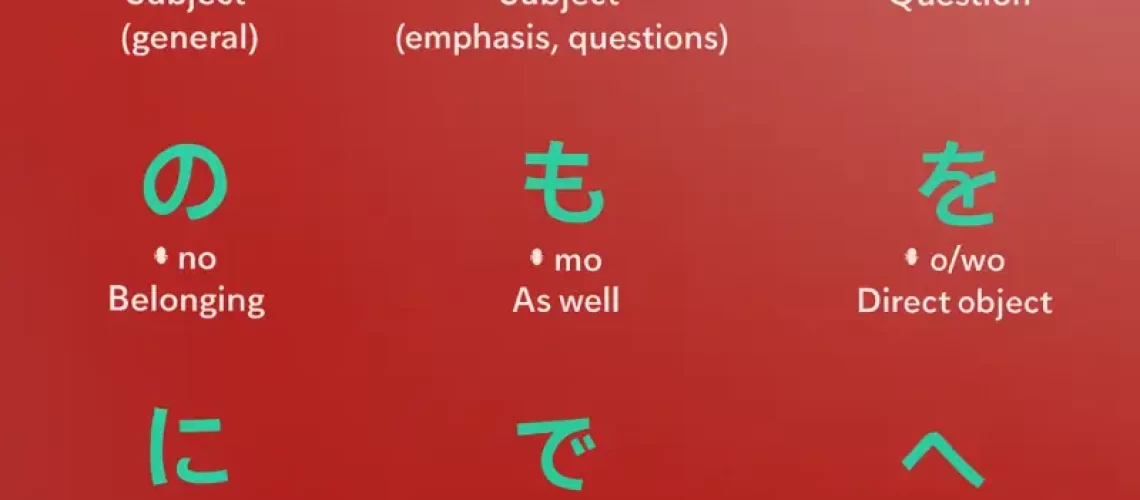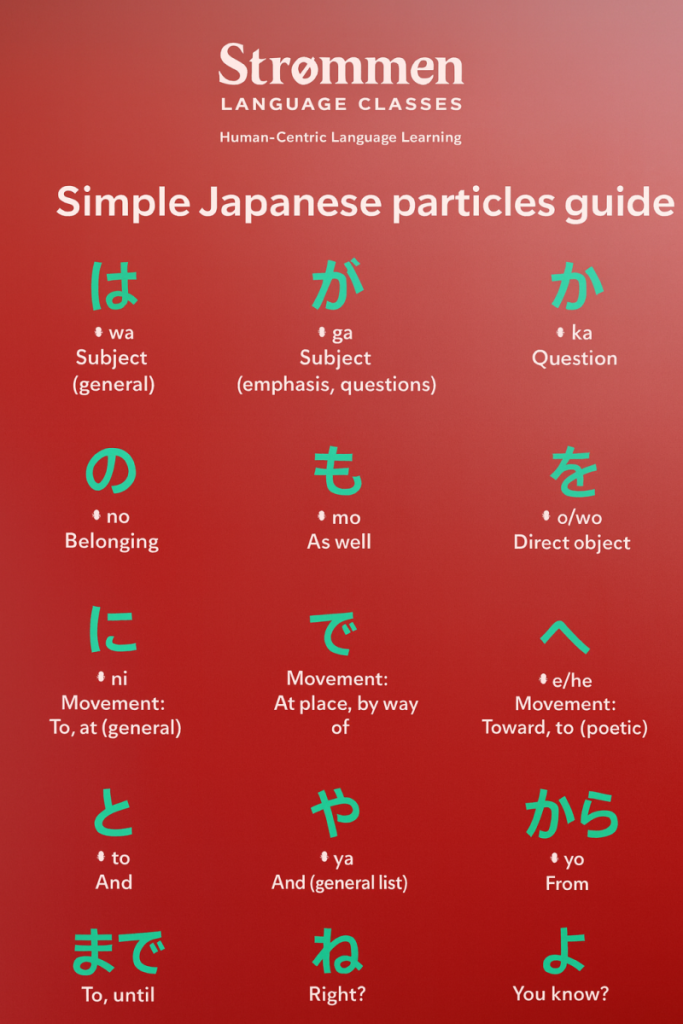15 Essential Japanese Particles and What They Mean
Communicate more effectively with our Japanese particle guide.
Although grammar doesn’t always get your heart racing, it is essential for communication. If you’re learning Japanese, getting familiar with these little “connector words” — particles — is essential to expressing your meaning clearly.
Japanese particles, defined
Japanese particles are function words that attach to other words to give context. They don’t change form like verbs or nouns (which can be conjugated or pluralized).
In English, we largely rely on word order to give context (for example: “Birds eat fish” – the subject comes first). We also have some particles (e.g., “in”, “and”, “to”). But in Japanese, particles are very important — they tell you who is doing what, to whom, where, when, etc.
For instance:
-
“I eat a fish.” → わたし は さかな を たべます。 (Watashi wa sakana o tabemasu.)
-
“A fish eats me.” → わたし を さかな は たべます。 (Watashi o sakana wa tabemasu.)
Swapping the particles は (wa) and を (o) changes the meaning entirely.
How many Japanese particles are there?
There are a total of 188 Japanese particles in all! That may seem intimidating, but you do not need to learn them all at once.
We’ve selected a list of the most common, useful ones. This is a great place to begin (though it doesn’t cover everyparticle).
The 15 must-learn Japanese particles
Here’s a handy chart to help you remember them:
| Particle | Hiragana | Romaji | Literal gist |
|---|---|---|---|
| は | wa | Subject (general) | |
| が | ga | Subject (emphasis, questions) | |
| か | ka | Question | |
| の | no | Belonging / ‘of’ | |
| も | mo | As well / also | |
| を (o/wo) | o / wo | Direct object | |
| に | ni | Movement: to, at (general) | |
| で | de | Movement: at place, by way of | |
| へ | e / he | Movement: toward, to (poetic) | |
| と | to | And (specific list) | |
| や | ya | And (general list) | |
| から | kara | From | |
| まで | made | To, until | |
| ね | ne | Right? (tag) | |
| よ | yo | You know? / emphasis |
1. は (wa)
Hiragana: は — Romaji: wa
Example: なおみ は アメリカじん です。
(Naomi wa amerikajin desu.)
“Naomi is an American.”
The particle は marks the subject or actor of the sentence. In this case, it shows the sentence is about Naomi.
Note: While the hiragana symbol is “ha”, when used as this particle it is pronounced “wa”.
2. が (ga)
Hiragana: が — Romaji: ga
Example: なおみ が アメリカじん です。
(Naomi ga amerikajin desu.)
“Naomi is an American.”
Similar function to は, but used for emphasis—often when distinguishing or after question words like “who/what”. It indicates: “It is Naomi (and not someone else) who is American.”
3. か (ka)
Hiragana: か — Romaji: ka
Example: だれ が 来ます か。
(Dare ga kimasu ka.)
“Who will come?”
Adding か at the end of a sentence turns it into a question.
4. の (no)
Hiragana: の — Romaji: no
Example: 弟 の いぬ です。
(Otōto no inu desu.)
“It’s my younger brother’s dog.”
This particle functions like “’s” or “of” in English — showing possession, belonging or description.
5. も (mo)
Hiragana: も — Romaji: mo
Example: わたし も。
(Watashi mo.)
“Me too.” / “Also me.”
This particle means “also, too, as well.” It can also emphasise “any” in negative sentences.
6. を (o/wo)
Hiragana: を — Romaji: o / wo
Examples: コーヒー を 飲みます。 (Kōhī o nomimasu.) — “I drink coffee.”
ご飯 を たべます。 (Gohan o tabemasu.) — “I eat rice.”
The particle を marks the direct object — the thing being acted upon by the verb.
7. に (ni)
Hiragana: に — Romaji: ni
Examples: 日本 に いきます。 (Nihon ni ikimasu.) — “I’m going to Japan.”
十一時 に 寝ます。 (Jū-ichi-ji ni nemasu.) — “I go to bed at eleven o’clock.”
It indicates direction/destination (“to”) or time (“at”).
8. で (de)
Hiragana: で — Romaji: de
Examples: バス で いきます。 (Basu de ikimasu.) — “I go by bus.”
レストラン で すし を 食べます。 (Resutoran de sushi o tabemasu.) — “I eat sushi at a restaurant.”
This particle shows where or by what means an action takes place — “at”, “by”, or “via”.
9. へ (e/he)
Hiragana: へ — Romaji: e / he
Example: 東京 へ 行きます。 (Tōkyō e ikimasu.) — “I head toward Tokyo.”
Like に, へ marks direction toward a place, but with a nuance of “heading toward/going to” rather than simply “to”. More poetic.
10. と (to)
Hiragana: と — Romaji: to
Example: ドレス と カラオケマシン を 購入しました。 (Doresu to karaoke mashin o kōnyū shimashita.) — “I bought a dress and a karaoke machine.”
This particle means “and/with” when you’re listing items specifically and completely.
11. や (ya)
Hiragana: や — Romaji: ya
Example: トム や マリー は パーティー に いました。 (Tomu ya Marī wa pātī ni imashita.) — “Tom and Mary were at the party.”
This means “and” as well, but is used when you are listing some items and implying there may be more.
12. から (kara)
Hiragana: から — Romaji: kara
Example: 仕事 から 家 に 帰ります。 (Shigoto kara ie ni kaerimasu.) — “I return home from work.”
It means “from” — describing origin in space or time (e.g., “from noon until three”). Often paired with まで (made).
13. まで (made)
Hiragana: まで — Romaji: made
Example: パリ から 東京 まで の 距離 は どれくらいです か? (Pari kara Tōkyō made no kyori wa dore kurai desu ka?) — “How far is it from Paris to Tokyo?”
This particle means “to” or “until” — both for space and time.
14. ね (ne)
Hiragana: ね — Romaji: ne
Example: 今日は土曜日ですね。 (Kyō wa do-yōbi desu ne.) — “Today is Saturday, right?”
This tag at the end of a sentence is like “isn’t it?” or “right?” — seeking listener agreement or confirmation.
15. よ (yo)
Hiragana: よ — Romaji: yo
Example: 今日は土曜日ですよ。 (Kyō wa do-yōbi desu yo.) — “It’s Saturday, you know!”
Used at the end of a sentence to add emphasis or conviction — telling the listener something new or important.
And that’s your first 15 basic Japanese particles explained
You’ve learned the fifteen most common Japanese particles — well done!
Of course, there are many more particles beyond this list — but this gives you a solid foundation to decode sentences and make yourself understood.
Now all it takes is practice and review. Use the chart from above whenever you feel stuck.
If you’re ready to keep going — from “Watashi wa …” to “日本語を話しますか?” — you can learn Japanese, and we’re here to help. Start your journey today.





